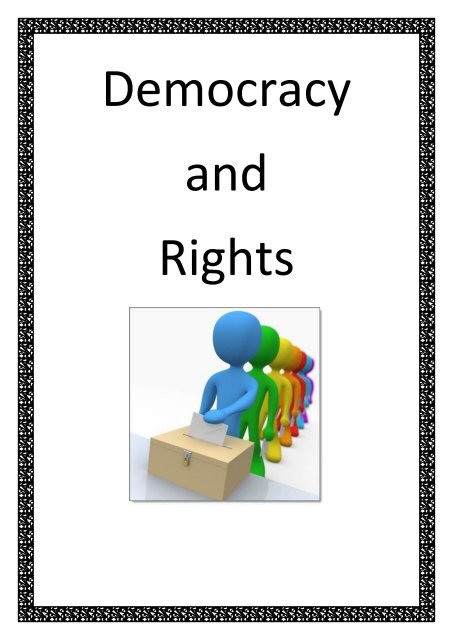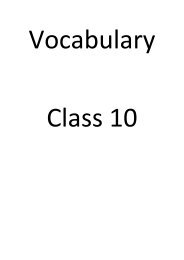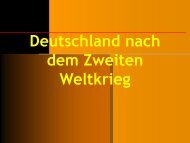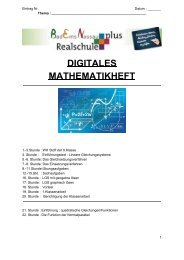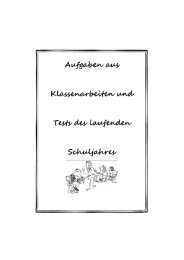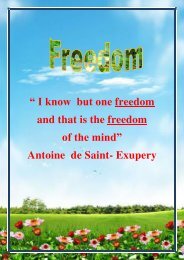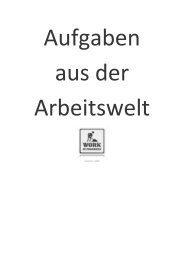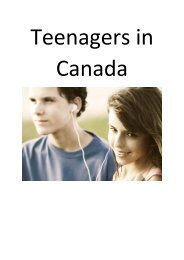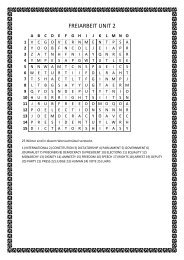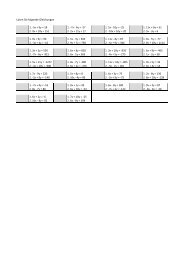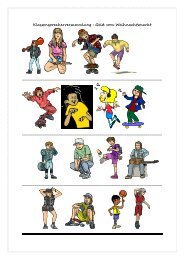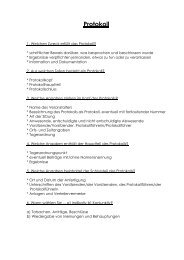Alles Rights
Create successful ePaper yourself
Turn your PDF publications into a flip-book with our unique Google optimized e-Paper software.
Democracy<br />
and<br />
<strong>Rights</strong>
I HAVE A DREAM – EXERCISES<br />
Figures of Speech<br />
Certain rhetorical devices called FIGURES OF SPEECH are used in both poetry and prose to make ideas more<br />
memorable and forceful. For centuries speakers and writers have known that such well said devices affect<br />
listeners and readers in powerful ways.<br />
Alliteration – repetition of a sound, normally a consonant, at the beginning of neighbouring words, to<br />
produce a rhythmic effect. (Around the rugged rock the ragged rascal ran)<br />
Allusion – the direct or indirect reference to something/somebody the reader or listener is supposed to<br />
recognize (e.g. historical events, literature, Bible,…)<br />
Anaphora – repetition of a word or phrase at the beginning of a sentence, verse or paragraph. (I have a<br />
dream… I have a dream…)<br />
Metaphor – comparison between two things (without using the words ‘as’ or ‘like’) which are basically<br />
quite unlike. (There’s daggers in men’s smiles. Macbeth)<br />
Simile – also a comparison, but while a methaphor says that something is like something else, a simile<br />
says that something is like something else, and uses the words ‘like’ or ‘as’ to draw that comparison. (the<br />
storm had blown itself out like a candle)<br />
1. "Five score years ago," the opening phrase of King's speech, is an ALLUSION to what or whom? Why was this an<br />
appropriate and strong way for King to begin his speech?<br />
2. King's speech contains other ALLUSIONS in addition to the one with which he opens his speech. Find an allusion<br />
to the Declaration of Independence and the Bible.<br />
3. Find an example of ALLITERATION in King's speech.<br />
4. Find an example of a METAPHOR.<br />
5. Find an example of a SIMILE.<br />
6. In the second paragraph, King says that "the life of the Negro is still sadly crippled by the manacles of<br />
segregation and the chains of discrimination." These words bring up strong IMAGES OF SLAVERY. Why would this<br />
be an effective method of moving his audience?<br />
7. Besides the famous "I have a dream" phrase, find two other examples of ANAPHORAS.<br />
8. List at least two possible effects upon King's audience of repeating the phrase, "I have a dream."<br />
9. Nearly every line of King's speech is filled with powerful images, or "MENTAL PICTURES," many created by using<br />
figures of speech. Images help audiences to feel what speakers/writers want them to feel, help them<br />
remember what they have read or heard, and help them understand difficult material. Write a well-developed<br />
paragraph telling which of King's images you find most powerful and appealing and explain why this image had<br />
meaning for you.<br />
Relating to the Dream<br />
1. What is your definition of RACISM?<br />
2. The CIVIL RIGHTS MOVEMENT was met with much opposition, from Southern governors and other elected officials<br />
to cross-burning members of the Ku Klux Klan. Unfortunately, Civil <strong>Rights</strong> opponents sometimes turned to<br />
violence against black leaders and members of the black community.<br />
o Why do you think extreme right-wing organizations such as the Klan would chose violence as a means to<br />
fight against the civil rights movement, even though their actions enraged the rest of the country and<br />
gained sympathy for the cause of Southern blacks?<br />
o Why do you think the black community withstood such violent attacks without responding with their own<br />
violent retaliations?<br />
3. Today's "SKINHEADS" share the same radical right-wing philosophies and views supporting white supremacy and<br />
segregation of the races that had been held by Hitler during World War II and the Klan during the civil rights<br />
movement. Do you think today's skinheads are dangerous? Why or why not?<br />
4. King was assassinated for his work in civil rights. A QUOTATION FROM THE BIBLE on<br />
the memorial at his gravesite reads, "Behold the dreamer. Let us slay him,<br />
and we will see what will become of his dream." What do you think has<br />
become of King's dream? Write two paragraphs: one telling in what ways the<br />
dream has been fulfilled and one telling what yet remains to be accomplished.
Do you<br />
respect other<br />
people's<br />
rights?<br />
What human<br />
rights organisations<br />
do<br />
you know<br />
about?<br />
What is the<br />
most important<br />
human right?<br />
Why?<br />
Do you think<br />
that religions<br />
respect<br />
human rights?<br />
Is human<br />
rights<br />
guaranteed<br />
in your<br />
country?<br />
Do you know<br />
someone<br />
whose rights<br />
have been<br />
violated?<br />
Do you know<br />
about anyone,<br />
personally or by<br />
name, who has<br />
had to fights for<br />
their rights?<br />
What rights<br />
should people<br />
who violate the<br />
rights have?<br />
What would the<br />
world be like if<br />
everyone<br />
respected the<br />
human rights?<br />
Do you find it<br />
possible that<br />
everyone in the<br />
world will have<br />
the same rights<br />
in the future?<br />
Why/why not?<br />
Poster source: http://www.undp.org/content/rbec/en/home/ourwork/democraticgovernance/human-rights/more-about-human-rights/
In 1989 the United Nations set the Convention of the <strong>Rights</strong> of the Child, the first legally binding<br />
international instrument to incorporate the full range of human rights (civil, cultural, economic, political and<br />
social rights), that Children everywhere have: the right to survival; to develop to the fullest; to protection<br />
from harmful influences, abuse; and to participate fully in family, cultural and social life.<br />
With these rights comes the obligation on governments not to infringe them. The task, however, must engage<br />
not just governments but all members of society. The standards and principles articulated in the Convention<br />
can only become a reality when they are respected by everyone . The only UN organization dedicated<br />
exclusively to help and to protect the lives and rights of children is UNICEF.<br />
Activities :<br />
-Separate the following words into POSITIVE and NEGATIVE:<br />
Discrimination, joy, violence, school/education, protection, hard work, racism, peace, food,<br />
hospital, family, orphans, illnesses, poverty, freedom, homeless, home, democracy, clothes,<br />
malnutrition.<br />
-Choose the correct words: CHILDREN HAVE THE RIGHTS TO:<br />
Education, health, drugs, no discrimination, identity ( name and nationality), death, war, life,<br />
hygiene, abuse, love.<br />
-Choose one of the rights and make a poster to illustrate young people’s human rights.
VOCABULARY<br />
Human rights<br />
1. Access<br />
2. arrest<br />
3. asylum<br />
4. charge<br />
5. choose<br />
6. conscience<br />
7. consent<br />
8. contrary<br />
9. cruel<br />
10. cultural<br />
11. degrading<br />
12. deny<br />
13. destruction<br />
14. dignity<br />
15. discrimination<br />
16. duty<br />
17. employment<br />
18. equal<br />
19. form<br />
20. frontier<br />
21. fundamental<br />
22. guilty<br />
23. hearing<br />
24. impartial<br />
25. impose<br />
26. incitement<br />
27. independent<br />
28. innocent<br />
29. interference<br />
30. jurisdictional<br />
31. law<br />
32. liberty<br />
33. life<br />
34. limitation<br />
35. manifest<br />
36. merit<br />
37. moral<br />
38. movement<br />
39. nationality<br />
40. omission<br />
41. persecution<br />
42. personality<br />
43. procedure<br />
44. prohibited<br />
45. protection<br />
46. proved<br />
47. punishment<br />
48. recognition<br />
49. remuneration<br />
50. reputation<br />
51. rights<br />
52. security<br />
53. servitude<br />
54. sex<br />
55. slavery<br />
56. spouse<br />
57. suffrage<br />
58. tolerance<br />
59. torture<br />
60. will<br />
Homewok<br />
1. Find the meaning of these words<br />
in the dictionary. Write them on<br />
your notebook.<br />
2. Place the correct word under the<br />
picture.<br />
3. Complete the sentences below<br />
using the words from the<br />
vocabulary.<br />
Complete the statements about human rights. Use the given words.<br />
Asylum, degrading, innocence, law, punishment<br />
1. His father died when he was three, his mother when he was only seven, and he grew<br />
up in a brutal and _________________ environment where he learnt to hold human life<br />
and human dignity in contempt.<br />
2. Assuming this violation occurred, what is the _______________ for breaking this law?<br />
3. Julia is studying __________________ and Rachel is majoring in business.<br />
4. He loved her fresh ________________, her selfless courage.<br />
5. The land which, a millennium before, had been a prison for the Jewish exiles was now<br />
their _______________ of refuge.
ACTIVITIES<br />
1. Look at the pictures above and write the human rights issues they represent.<br />
2. Discussion. Answer these questions.<br />
What do human rights mean to you?<br />
Are human rights respected in your country?<br />
What are the common human rights issues in your country?<br />
3. Write sentences about human rights using these verbs.<br />
SPEAK<br />
HAVE<br />
VIOLATE<br />
UNDERSTAND<br />
HAPPEN<br />
DEDICATE
4. Design a slogan about human rights and explain it to the class.<br />
5. Write the most important human rights that every person has in the concept map.<br />
Human rights
Hassi El Frid S.S.<br />
Lesson 10: Child Labour<br />
Miss Amira CHATTI<br />
Before You Read:<br />
Activity 1. Examine the following set of pictures and say what the common point between<br />
them is:<br />
…………………………………………………………………………………………………<br />
Activity 2. Watch the next video and answer the questions below:<br />
Are children supposed to take up jobs?<br />
…………………………………………………………………………………………………<br />
How are their work conditions?<br />
…………………………………………………………………………………………………<br />
Cross the odd man out:<br />
poverty – illness – happiness – harm – safety – education –<br />
injury – pocket money - exploitation – fun – maltreatment.<br />
Activity 3. Fill in the blanks with words from the list:<br />
lowest – Asia – Europe - Africa – developed – increasing –<br />
underdeveloped – highest – decreasing<br />
According to statistics, the (1) ……..……..………… percentage of child labour is in (2)<br />
……..……..………… countries in (3) ……..……..…………and (4) ……..……..………….<br />
However, the (5) ……..……..………… percentage is in (6) ……..……..………… countries in<br />
(7)<br />
……..……..…………. In fact, these percentages are (8) ……..……..………… in Africa. In<br />
contrast, they are (9) ……..……..………… in Europe.<br />
As You Read:<br />
Activity 1. Read the starting sentence of every paragraph in the text page 63 and<br />
match each paragraph with its corresponding heading:<br />
a. The outcomes of child labour § …<br />
b. The figures counting child labour § …<br />
c. The work conditions of child labourers § …<br />
d. The reasons behind child labour § …<br />
2 nd Year Arts Skill in Focus: Reading
Hassi El Frid S.S.<br />
Lesson 10: Child Labour<br />
Miss Amira CHATTI<br />
Activity 2. Fill in the table with the missing information from the text:<br />
Age Types of Job Work conditions<br />
From ……..<br />
to ……..<br />
In rural areas: ……..……..…….. and ……..……..……..<br />
In urban areas: ……..……..…….. , ……..……..…….. ,<br />
……..……..…….. , and ……..……..……..<br />
……..……..…………<br />
……..……..…………<br />
……..……..…………<br />
Activity 3. Say whether the following are true or false. Justify your answer from the<br />
text:<br />
Working children enjoy comfortable conditions. [§ 2]<br />
…………………………………………………………………………………………………<br />
Working children take up jobs for the sake of entertainment. [§ 3]<br />
…………………………………………………………………………………………………<br />
School attendance is very difficult for working children. [§ 4]<br />
…………………………………………………………………………………………………<br />
Activity 4: Find words in the text that mean the same as:<br />
calculated approximately (§ 1): ……..……..………………...<br />
making goods by industrial process (§ 1): ……..……..………<br />
to suffer something that’s painful (§ 2): ……..……..………<br />
to help to cause something (§ 4): ……..……..………………<br />
After You Read:<br />
Activity 1. Examine the following set of pictures and say what these children should be<br />
doing instead of working:<br />
…………………………………………………………………………………………………<br />
Activity 2. Think of three possible solutions for working children:<br />
………………………………………<br />
………………………………………<br />
………………………………………<br />
2 nd Year Arts Skill in Focus: Reading


